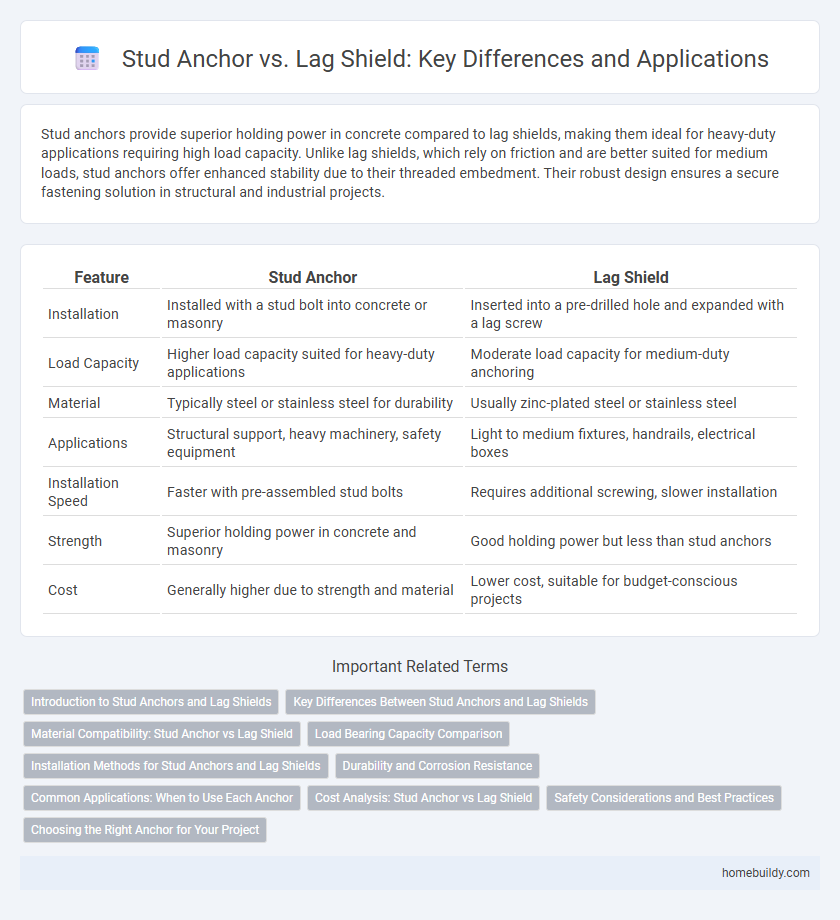Stud anchors provide superior holding power in concrete compared to lag shields, making them ideal for heavy-duty applications requiring high load capacity. Unlike lag shields, which rely on friction and are better suited for medium loads, stud anchors offer enhanced stability due to their threaded embedment. Their robust design ensures a secure fastening solution in structural and industrial projects.
Table of Comparison
| Feature | Stud Anchor | Lag Shield |
|---|---|---|
| Installation | Installed with a stud bolt into concrete or masonry | Inserted into a pre-drilled hole and expanded with a lag screw |
| Load Capacity | Higher load capacity suited for heavy-duty applications | Moderate load capacity for medium-duty anchoring |
| Material | Typically steel or stainless steel for durability | Usually zinc-plated steel or stainless steel |
| Applications | Structural support, heavy machinery, safety equipment | Light to medium fixtures, handrails, electrical boxes |
| Installation Speed | Faster with pre-assembled stud bolts | Requires additional screwing, slower installation |
| Strength | Superior holding power in concrete and masonry | Good holding power but less than stud anchors |
| Cost | Generally higher due to strength and material | Lower cost, suitable for budget-conscious projects |
Introduction to Stud Anchors and Lag Shields
Stud anchors and lag shields are essential fasteners for securing heavy loads in concrete and masonry. Stud anchors consist of threaded rods embedded into pre-drilled holes with adhesive or mechanical expansion, providing high load-bearing capacity. Lag shields are metal sleeves expanded by a lag bolt, ideal for medium loads and easier installation in softer materials like brick or hollow block.
Key Differences Between Stud Anchors and Lag Shields
Stud anchors provide superior load-bearing capacity and are ideal for heavy-duty applications, while lag shields offer easier installation in softer materials like drywall or masonry. Stud anchors create a mechanical interlock inside drilled holes, ensuring strong resistance against tension and shear forces, whereas lag shields primarily rely on friction to hold fasteners in place. The selection between stud anchors and lag shields depends on the substrate type, load requirements, and environmental conditions, with stud anchors favored for structural stability and lag shields suited for lighter, non-structural tasks.
Material Compatibility: Stud Anchor vs Lag Shield
Stud anchors are typically made from stainless steel or carbon steel, offering superior corrosion resistance and strength suitable for heavy-duty applications. Lag shields, often made from zinc-plated or galvanized steel, provide adequate protection in lighter-duty environments but may corrode faster in harsh conditions. Material compatibility depends on the substrate and environmental exposure, with stud anchors preferred in concrete or masonry for long-term durability, while lag shields suit softer substrates but may require more frequent inspection.
Load Bearing Capacity Comparison
Stud anchors provide significantly higher load bearing capacity compared to lag shields due to their deep embedment and superior expansion mechanisms in concrete substrates. Load tests show stud anchors withstand tensile loads exceeding 10,000 pounds in standard concrete, while lag shields typically handle under 5,000 pounds. This difference makes stud anchors the preferred choice for heavy-duty structural applications requiring maximum load resistance.
Installation Methods for Stud Anchors and Lag Shields
Stud anchors install by drilling a precise hole into the base material, inserting the anchor, and tightening the nut to expand the anchor's sleeve for a secure hold. Lag shields require drilling an oversized hole, inserting the shield, and driving a lag screw into the shield to wedge it against the hole wall. Stud anchor installation offers a cleaner installation process with less potential for material damage compared to the more forceful expansion method used with lag shields.
Durability and Corrosion Resistance
Stud anchors exhibit superior durability and corrosion resistance compared to lag shields, making them ideal for heavy-duty applications in harsh environments. Made from high-strength steel or stainless steel, stud anchors resist deformation and corrosion, ensuring long-term structural integrity. Lag shields, often composed of zinc-plated steel, provide moderate corrosion resistance but lack the robust endurance of stud anchors in aggressive conditions.
Common Applications: When to Use Each Anchor
Stud anchors are ideal for securing heavy loads in concrete and masonry where precise placement and high shear strength are required, commonly used in structural beams and heavy equipment mounting. Lag shields work best in softer materials like brick or block, providing a secure, expandable grip ideal for medium-duty applications such as attaching electrical boxes or light fixtures. Selecting between stud anchors and lag shields depends on the substrate strength and load requirements, ensuring optimal performance and safety in construction projects.
Cost Analysis: Stud Anchor vs Lag Shield
Stud anchors typically offer a cost-effective solution compared to lag shields, with lower material and installation expenses influencing overall project budgets. Lag shields require additional hardware and labor for proper securing, often increasing total costs when anchoring in masonry or concrete. Analyzing long-term durability and load capacity also impacts value, where stud anchors may reduce maintenance costs over time, providing better lifecycle cost efficiency.
Safety Considerations and Best Practices
Stud anchors offer superior load distribution by embedding directly into concrete or masonry, reducing the risk of pull-out compared to lag shields, which rely on friction within drilled holes. For optimal safety, ensure precise hole sizing and proper setting torque when installing stud anchors, minimizing stress concentrations and preventing structural damage. Regular inspections for corrosion and integrity are critical to maintain anchorage reliability under dynamic loads.
Choosing the Right Anchor for Your Project
When selecting the right anchor for your project, stud anchors provide superior load-bearing capacity and are ideal for heavy-duty applications such as securing structural elements to concrete. In contrast, lag shields are typically used in softer materials like hollow brick or block, offering easier installation but lower strength performance. Evaluating the substrate type and load requirements ensures the best anchoring solution between stud anchors and lag shields.
Stud anchor vs lag shield Infographic

 homebuildy.com
homebuildy.com